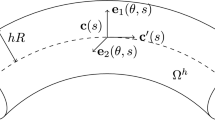Summary
An analysis is presented of the flow of an elasticoviscous liquid in a pipe of circular cross-section, coiled in a circle oflarge radiusR, under the influence of a pressure gradient oscillating (about a zero mean) with frequencyn. Of particular interest is the secondary flow set up in the cross-section of the pipe due to centrifugal effects. For sufficiently small values ofn, it is found that the flow pattern approaches that which would be produced by a steady pressure gradient having the same instantaneous value (Thomas andWalters 1963), and of the type that one would be led to expect by centrifugal effects. For large values ofn, the flow in the interior of the pipe, away from the wall, is spectacularly reversed, flow now being directed towards the centre of curvature, elasticity having the effect of reducing the critical (high) frequencyn = n c which onsets flow reversal.
Zusammenfassung
Eine Analyse der Strömung einer elasto-viskosen Flüssigkeit in einer Röhre von rundem Querschnitt, die in einem Kreis mit einemgroßen RadiusR gewunden ist, wird unter dem Einfluß eines Druckgradienten, der mit der Frequenzn oszilliert (um einen Nulldurchschnitt), dargestellt. Von besonderem Interesse ist die Sekundärströmung, die in dem Querschnitt der Röhre unter dem Einfluß der Zentrifugalwirkungen entsteht. Für genügend kleine Werte vonn wird herausgefunden, daß das Strömungsbild sich demjenigen annähert, das von einem stationären Druckgradienten erzeugt werden würde, der denselben augenblicklichen Wert besitzt (Thomas andWalters 1963) und dem Typus angehört, den man aufgrund der Zentrifugalwirkungen erwarten würde. Für große Werte vonn wird die Strömung im Inneren der Röhre, d. h. von den Rändern entfernt, in spektakulärer Weise umgekehrt; jetzt wird die Strömung zum Krümmungsmittelpunkt hin gerichtet, und die Elastizität hat die Wirkung, die kritische (hohe) Frequenzn = n c zu reduzieren, bei der die Strömungsumkehr beginnt.
Similar content being viewed by others
References
Dean, W. R. Phil. Mag.4, 208–223 (1927).
Dean, W. R. Phil. Mag.5, 673–695 (1928).
Jones, J. R. andT. S. Walters Rheol. Acta6, 240–245 (1967).
Jones, J. R. Proc. Camb. Phil. Soc.68, 731–750 (1970).
Luke, Y. L., Integrals of Bessel Functions (New York 1962).
Lyne, W. H., J. Fluid Mech.50, 13–31 (1970).
Oldroyd, J. G. Proc. Roy. Soc. A.200, 523–541 (1950).
Thomas, R. H. andK. Walters J. Fluid Mech.16, 228–242 (1963).
Watson, G. N., A Treatise on the Theory of Bessel Functions, 2nd Edn. (London 1966).
Zalosh, R. G. andW. G. Nelson J. Fluid Mech.59, 693–705 (1973).
Author information
Authors and Affiliations
Additional information
With 2 figures
Rights and permissions
About this article
Cite this article
James, P.W. Unsteady elastico-viscous flow in a curved pipe. Rheol Acta 14, 679–687 (1975). https://doi.org/10.1007/BF01515925
Received:
Issue Date:
DOI: https://doi.org/10.1007/BF01515925




